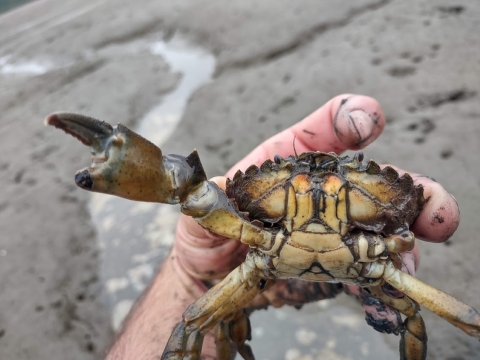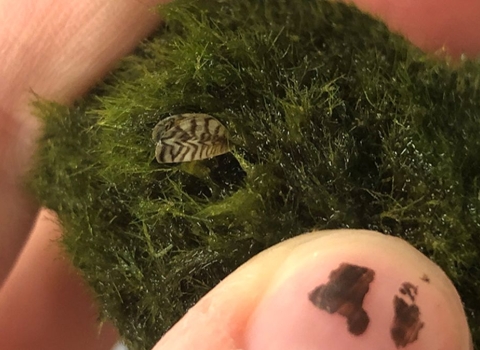They’re described as one of the biggest threats to Alaska’s marine environment, and you’ve probably never heard of them. This year, they were found in the state for the first time. Ever. Say hello to the invasive green crab.
Invasive green crabs (aka European green crabs, Carcinus maenas) are shore crabs native to Europe and North Africa. Though they’re new to Alaska, they’re not new to the States. They have been wreaking havoc on the Atlantic Coast since the 1800s, likely transported across the ocean by ships in their ballast water. In 1989, they made their way to the Pacific Coast. Since then, these invasive green crabs have slowly expanded north and south, either hitchhiking or floating in larval stages on ocean currents. Until, voila, they arrived in Southeast Alaska.
To see a detailed map of their spread, check out the work of the Washington Sea Grant Crab Team.
Hungry little crabs with a big impact
Despite their small size, ranging approximately 2.5 to 4 inches in shell width, invasive green crabs have outsized impacts on ecosystems. They’re generalist predators with a fierce appetite — a single crab can consume upwards of 20 clams per day. They feed on mussels, clams, juvenile oysters, native crabs, and juvenile salmon. Recently, they’ve been documented to eat eelgrass in British Columbia. They compete with native crab species, such as Dungeness crabs and red rock crabs, for forage and habitat.
As if their appetite wasn’t enough, invasive green crab destroy eelgrass beds. Eelgrass beds are important for:
- Juvenile salmon and other fish as nursery habitat.
- Herring and other fish as spawning habitat.
- Bivalves, such as clams and mussels, and crustaceans as sediment habitat.
- Migratory and resident shorebirds and sea ducks as foraging habitat.
- Marine mammals, such as sea otters, as foraging habitat for prey.
The consequences of degradation and destruction of eelgrass beds have the potential to cascade throughout the entire ecosystem.
Invasive green crabs tunnel and burrow into sediment, and clip blades of seagrass searching for food and shelter, damaging eelgrass meadows. In Newfoundland, researchers found between a 50 and 100 percent decline in eelgrass cover after these habitats were invaded by green crabs. The more crabs and the longer they had been there, the greater the negative effects on eel grass.
The negative impacts can happen fast. Within just four weeks of infestation, researchers in British Columbia found eelgrass density declined up to 81 percent in areas of high invasive green crab density.
A crabby welcome to Alaska
Ultimately, the arrival of invasive green crabs in Alaska has potentially huge implications for subsistence, recreational, and commercial fisheries. Even before they arrived in Alaska, the state has been warning of the damage they could cause. It’s no wonder they are listed on 100 of the World’s Worst Invasive Alien Species.
It’s not all doom and gloom though!
Fortunately, agencies and partners across Alaska have been surveying for invasive green crabs since the 2000s. This preparation allowed the Metlakatla Indian Community Department of Fish and Wildlife to first detect the crabs during a survey on Annette Islands Reserve in July 2022. Since detection, activities on Annette Islands Reserve have shifted from early detection surveying for invasive green crabs to intensive trapping to minimize the population before it can further expand its range.
Learn to identify this critter 🦀
Despite the common name, invasive green crabs aren’t always green. They can range from dark brown to green, and even be yellow or orange. The tell-tale sign for identifying an invasive green crab is the five spines behind each eye. Thankfully, no native Alaska crabs have five spines. Juvenile Dungeness crabs are the species most likely to be mistaken for the invaders, but they have ten spines behind each eye. Check out Kachemak Bay Research Reserves’ crab identification guide. Test your identification skills on photos of real crabs.
We need your help!
- Report any green crab sighting. If you’re on Annette Islands Reserve, call (907) 886-FISH. If you’re anywhere else in Alaska, report it to Alaska Department of Fish and Game’s online Alaska Invasive Species Reporter or the Invasive Species Hotline at (877) INVASIV. Don’t keep or kill the crab, but rather take plenty of photos- along with a standard size reference item, such as a coin or key. Then, send your photos to the Alaska Department of Fish and Game (tammy.davis@alaska.gov).
- If you’re interested in getting your hands wet and dirty, you can volunteer to be a citizen scientist by joining the marine invasive species invasive species
An invasive species is any plant or animal that has spread or been introduced into a new area where they are, or could, cause harm to the environment, economy, or human, animal, or plant health. Their unwelcome presence can destroy ecosystems and cost millions of dollars.
Learn more about invasive species citizen monitoring network. Contact ADF&G Invasive Species Program coordinator at 1–877-INVASIV to get involved! - If you’re beachcombing, keep an eye out for carapaces while strolling the coast. The carapace, the hard upper shell of a crab, is shed during molting. Looking for carapaces is a great way to detect the presence of invasive green crab, as well as other native species. Not only is it a fun treasure hunt, but you are helping to track and detect invasive species! Just make sure to count the spines — remember five behind the eyes = invasive!











